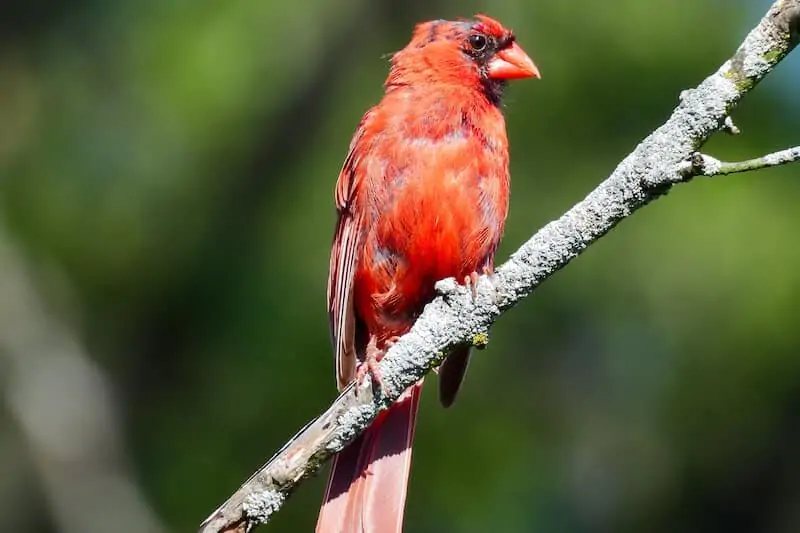Every year, I come across photos of birds in people’s yards with no feathers on their head that are posted online. Seeing this baldness, which makes songbirds resemble little vultures, can be quite frightening! Why do birds lose their head feathers? Is this something to be concerned about, or is it normal? Let’s find out right now.
WHY DO BIRDS LOSE FEATHERS ON THEIR HEAD?
Some head feathers are lost entirely, while others are only lost in the front half of the head. Why this happens is still largely unknown, but there are two possible explanations that we’ll look into later.

BIRDS LOSE FEATHERS DUE TO MOLTING
Your backyard birds will have to molt throughout the year. The process of molting involves the removal of an old feather in order for a new feather to grow in its place. Feathers are deemed dead tissue, much like your fingernails or hair. They don’t rebuild themselves once they’ve fully formed. As a result, they get worn down after a while, with rough edges, and must be replaced.
Feather loss is distributed rather than occurring all at once for the majority of your backyard birds as they molt. They only lose a few feathers at a time, and to our eyes, it isn’t very apparent or they may simply appear a little tattered or scruffy. Birds have also been documented to conceal themselves during molting, thus we may not normally see it.
Blue Jays and Northern Cardinals are two birds that have been observed to be completely bald. It is considered more or less normal behavior for these two species to have an irregular molt pattern, which has been observed frequently enough.
BALD CARDINALS

In the late summer and early autumn, Northern Cardinals molt once per year. They have completed their mating obligations and food is still plentiful, so they have the energy to grow new feathers at this time of year. Several cardinals may seem a little “ratty” for a few weeks after they molt in staggered fashion. They look a little unkempt or evenMissing their crest, with just a few sparse patches on their body. Some cardinals, on the other hand, lose all of their feathers at once and expose their underlying black skin.
This bald phenomenon occurs on rare occasions when researchers studying banded cardinals witness it. The cardinals can regenerate their head feathers within a few weeks since they are banded, allowing them to follow up with the same cardinal and record that they will.
If you’ve ever thought cardinal males look redder throughout the winter, you may be right. Some males might have gray tips on their neck and back feathers even after a molt. These tips fall off as the autumn and winter wear on, revealing more crimson.
BALD BLUE JAYS

The Blue Jays experience a full molt in late summer. They lose feathers all the time, and when they replace them, you wouldn’t notice. A few blue jays, on the other hand, lose all of their head feathers at once. Cardigans’ baldes are usually more shiny than this. If you examine the Blue Jays’ head closely, you may notice the new feathers pushing out the old.
BIRDS LOSE FEATHERS DUE TO LICE AND MITES
The Blue Jays and Cardinals molt at the end of summer through the early autumn, as we previously mentioned. However, in the early spring, these birds, especially cardinals, are sometimes seen with a bald head. This would be a bad time to molt, and their ability to find a partner would be hampered until their feathers grew back. So what else might be going on?
Several bird lice or feather mites are thought to be the underlying reason at times. Birds cannot clean their own head, so they preen and clean their feathers with their beak. Mites might be scratching their feathers off their head, using their feet and branches, in order to rid themselves of the infestation. If they are irritating and itching, it’s possible they’re doing so.
Unfortunately, evidence of mites or parasite problems is rarely seen upon visual examination, making it difficult to determine if this is a problem. These birds are thought to be able to regrow their head feathers in a few weeks, much like molting.
BIRDS LOSE FEATHERS DUE TO ENVIRONMENTAL TOXINS
This is a idea that I have seen less often since there isn’t any research to support it at the moment. Others think that pesticides, herbicides, plastics, chemicals, and toxins are polluting bird seed supplies as a result of the increase in those items in the environment. Cardinals have been seen bald or stay bald for lengthy periods of time by witnesses, according to anecdotal reports. According to some, two, three, or more bald cardinals were seen at the same time, and the situation is bigger than just molting. Chemicals and pesticides can have a significant negative impact on ecosystems, as we know now. To determine if these elements are the reason for baldness in birds, more specific study would be required.
CONCLUSION
We don’t know the definitive cause of bird baldness until it is further investigated. The most likely cause is molting, but we don’t know why some birds within a species molt in one way while others do not. If you notice bald birds during the spring or early summer, when molting is not yet complete, parasites are a strong suspect. There is no proof that it is caused by a viral illness at this time.
Most birds do just fine until their new feathers come in, and it may not appear ideal for them or seem that they are creepy.
